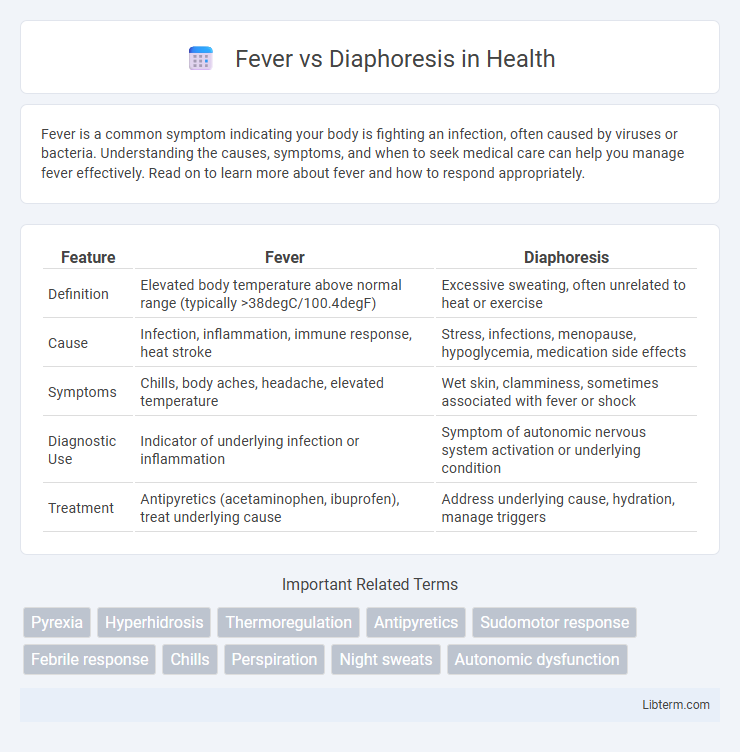Fever is a common symptom indicating your body is fighting an infection, often caused by viruses or bacteria. Understanding the causes, symptoms, and when to seek medical care can help you manage fever effectively. Read on to learn more about fever and how to respond appropriately.
Table of Comparison
| Feature | Fever | Diaphoresis |
|---|---|---|
| Definition | Elevated body temperature above normal range (typically >38degC/100.4degF) | Excessive sweating, often unrelated to heat or exercise |
| Cause | Infection, inflammation, immune response, heat stroke | Stress, infections, menopause, hypoglycemia, medication side effects |
| Symptoms | Chills, body aches, headache, elevated temperature | Wet skin, clamminess, sometimes associated with fever or shock |
| Diagnostic Use | Indicator of underlying infection or inflammation | Symptom of autonomic nervous system activation or underlying condition |
| Treatment | Antipyretics (acetaminophen, ibuprofen), treat underlying cause | Address underlying cause, hydration, manage triggers |
Understanding Fever and Diaphoresis
Fever is a regulated rise in body temperature usually triggered by infection or illness, indicating the immune system's response to harmful pathogens, whereas diaphoresis refers to excessive sweating often caused by autonomic nervous system activation during fever episodes or other conditions like anxiety or heart issues. Differentiating fever from diaphoresis involves recognizing fever as a core temperature elevation measured with thermometers, while diaphoresis is a physical symptom resulting from temperature regulation efforts or stress responses. Understanding these distinct physiological processes is essential for accurate diagnosis and treatment of underlying medical causes.
Key Differences Between Fever and Diaphoresis
Fever is an elevated body temperature regulated by the hypothalamus as a response to infection or inflammation, typically above 38degC (100.4degF), whereas diaphoresis refers to excessive sweating often triggered by anxiety, heat, or certain medical conditions without an increase in core temperature. Fever involves systemic inflammatory processes and an increase in metabolic rate, while diaphoresis is a symptom of autonomic nervous system activation for thermoregulation or stress response. Key diagnostic criteria distinguish fever by measuring body temperature elevation, whereas diaphoresis is identified through observable sweating patterns without necessarily altered thermoregulatory set points.
Causes of Fever
Fever is primarily caused by infections such as bacterial, viral, or fungal pathogens triggering the hypothalamic set point alteration, while diaphoresis results from excessive sweating due to autonomic nervous system activation. Common causes of fever include influenza, pneumonia, urinary tract infections, and autoimmune diseases, which promote the release of pyrogens like interleukin-1 and tumor necrosis factor. Unlike diaphoresis, which can occur during temperature regulation or stress, fever represents a controlled physiological response to illness aimed at inhibiting pathogen replication.
Common Triggers of Diaphoresis
Diaphoresis commonly occurs due to triggers such as intense physical exertion, heat exposure, anxiety, hypoglycemia, and infections, which stimulate excessive sweating as a thermoregulatory or stress response. Fever-induced diaphoresis arises when the body attempts to lower elevated core temperatures through sweating, driven by pyrogenic cytokines. Understanding these triggers is essential for differentiating primary diaphoresis from fever-related sweating in clinical diagnosis and treatment.
Symptoms Associated with Fever
Fever is characterized by an elevated body temperature usually above 38degC (100.4degF), often accompanied by chills, headaches, muscle aches, and fatigue, signaling an immune response to infection or inflammation. Diaphoresis, or excessive sweating, commonly occurs as a symptom during the febrile phase or when the fever breaks, helping the body regulate temperature through evaporative cooling. Monitoring associated symptoms like chills, shivering, and sweating patterns aids in distinguishing fever from diaphoresis and understanding the underlying medical condition.
Symptoms Linked to Diaphoresis
Diaphoresis is characterized by excessive sweating often triggered by conditions such as infections, hypoglycemia, or anxiety disorders. This symptom signals autonomic nervous system activation and is commonly accompanied by sensations of clamminess and chills. Unlike fever, diaphoresis does not necessarily involve an elevated body temperature but serves as a physiological response to underlying medical issues.
Diagnostic Approaches: Fever vs Diaphoresis
Diagnostic approaches for fever primarily involve measuring core body temperature using reliable tools like oral, tympanic, or rectal thermometers to confirm elevated temperatures above 38degC (100.4degF). In contrast, diagnosing diaphoresis centers on clinical observation of excessive sweating, often requiring assessment of underlying causes such as infections, endocrine disorders, or medication side effects through patient history and laboratory tests. Combining temperature readings with symptom evaluation and targeted diagnostic tests helps distinguish fever from diaphoresis, guiding appropriate treatment strategies.
Treatment Strategies for Fever and Diaphoresis
Treatment strategies for fever primarily involve antipyretic medications such as acetaminophen or ibuprofen to reduce elevated body temperature and address underlying infections with appropriate antibiotics if bacterial causes are confirmed. Management of diaphoresis centers on identifying and treating underlying conditions like infections, hyperthyroidism, or anxiety, along with supportive care including hydration and electrolyte balance. Both conditions may require environmental modifications such as cooling measures for fever and comfortable, breathable clothing to prevent excess sweating in diaphoresis.
When to Seek Medical Attention
Seek medical attention for fever when it exceeds 103degF (39.4degC), persists longer than three days, or is accompanied by symptoms like severe headache, difficulty breathing, or persistent vomiting. Diaphoresis, or excessive sweating, requires urgent evaluation if it occurs suddenly with chest pain, dizziness, or weakness, as it may indicate heart attack or other serious conditions. Timely medical intervention can prevent complications associated with prolonged fever or underlying causes of diaphoresis.
Preventive Measures and Health Tips
Effective preventive measures for fever include maintaining proper hygiene, staying hydrated, and avoiding contact with sick individuals to reduce infection risk. Diaphoresis prevention involves wearing breathable clothing, managing stress, and monitoring medications that may cause excessive sweating. Regular health check-ups can help identify underlying conditions that contribute to persistent fever or diaphoresis, enabling timely intervention.
Fever Infographic

 libterm.com
libterm.com